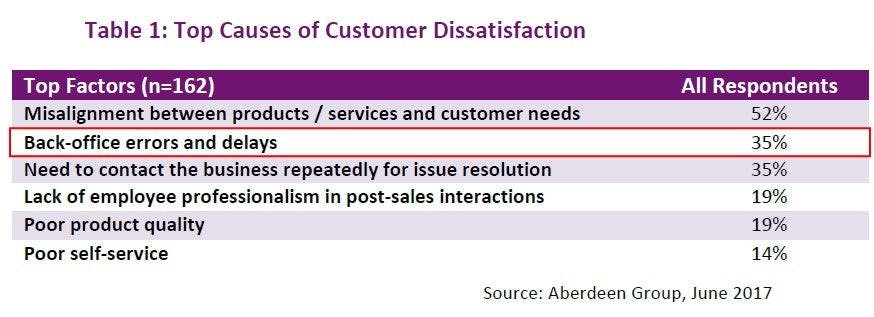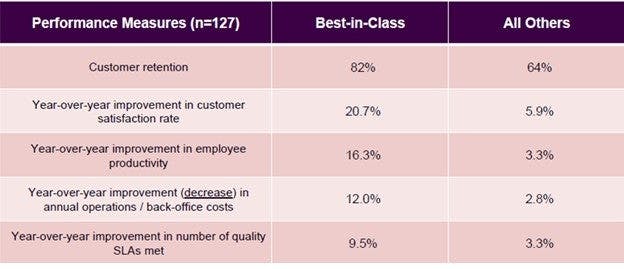
Back Office: What’s Changed and What’s the Same (2017-2024)


Note: The charts shared in this blog are excerpts from 4 different Aberdeen Knowledge Briefs from 2017, 2019, 2021 and 2024 respectively. The numbering of the charts/tables reflect the numbering in the original briefs.
In Aberdeen Strategy & Research’s latest report on back-office automation, Time for a Fresh Take on Back Office: Road to Efficiency and CX Excellence, Aberdeen found that despite technology and process-related advances in recent years, back offices are still struggling to achieve their cost, employee productivity, and customer experience goals.
Download the report: Time for a Fresh Take on Back Office.
Back-office operations are the typically non-customer-facing functions of an organization that execute the product orders and service inquiries of customers. So, what back-office automation have organizations been investing in, and why haven’t most organizations been able to move the dial for this mission critical part of the organizations? Let’s explore.
2017 – Back Office Impact on CX Quantified
Verint® first started partnering with Aberdeen Strategy & Research in 2017, when through his research on contact centers and customer experience (CX), Omer Minkara, VP and Principal Analyst at Aberdeen, realized that organizations were missing a key component to customer satisfaction and CX – the back office.
In his 2017 survey of CX leaders, he learned that the #2 cause of customer dissatisfaction was errors and delays in the back office.

Source: The Business Value of a Next-Generation Back Office, Aberdeen, 2017
In his report, The Business Value of a Next-Generation Back Office, Omer shared survey findings and his conclusion that traditional methods of managing back-office activities no longer worked.
Companies needed to expand their efficiency-centric mindset to include customer experience and back-office automation to achieve both cost AND CX goals.
To minimize delays and achieve service level agreements (SLAs), best-in-class organizations in 2017 were leveraging back-office automation solutions, such as:
- Robotic process automation (RPA), to automate repetitive tasks, and
- Workforce management, to align employee schedules and skills to work types and arrival patterns.
2019 – Modern Back Offices Are Balancing Cost with CX
In Aberdeen’s 2019 survey, errors and delays in the back office were still a top cause of customer dissatisfaction. At the time, Aberdeen found that organizations were addressing these issues by:
- Streamlining processes and driving consistency across teams
- Updating their outdated technologies for easier integration with newer systems.
In Aberdeen’s report, Essentials to Modernize Your Back Office, we saw that many of the efforts in 2019 focused on process optimization, using tools such as RPA and processing mining, as well as Lean/Six Sigma initiatives.

Source: Essentials to Modernize Your Back Office, Aberdeen, 2019
A few forward-thinking organizations were starting to implement solutions that could capture data in near-real time, improving their ability to not only monitor work items and their status of completion, but also measure employee activity and productivity.

Source: Essentials to Modernize Your Back Office, Aberdeen, 2019
2021 – CX Becomes the Top Priority for Back Office Leaders
2021 was when the balance shifted and improving customer experience became the top concern of back-office leaders, with controlling costs falling behind growing revenues and increasing employee productivity.

Source: Back-Office Agility Pivotal for Differentiated Customer Experiences, Aberdeen, 2021
Yet improving productivity requires a high level of operational agility or ability to adapt in real time to changes in volumes, priorities and customer demand. Aberdeen’s research found that best-in-class, back-office operations were leveraging three key capabilities to drive agility:
- Workload forecasting and optimization
- Real-time rebalancing of work
- Dynamic scheduling.

Source: Back-Office Agility Pivotal for Differentiated Customer Experiences, Aberdeen, 2021
2024 – Finding the Balance Between Efficiency and CX
In the 2024 research, Aberdeen found that the top goals of back-office leaders were a blend of drivers of efficiency and CX:
- Improve employee productivity and capacity
- Provide customers with greater visibility into relevant activity statuses
- Keep up with changing customer demand and business conditions.
In fact, inefficient use of the workforce and resources was the number one reason given as to why back-office leaders struggle with managing operating costs.
Today’s back-office leaders realize that they need to leverage back-office automation not only to improve processes, but also to improve employee productivity.

Source: Time for a Fresh Take on Back Office: Road to Efficiency and CX Excellence, Aberdeen, 2024
In Aberdeen’s 2024 report, Time for a Fresh Take on Back Office: Road to Efficiency and CX Excellence, in addition to using back-office automation to improve employee productivity, the report found that best-in-class operations were taking a new approach to standard work allocation practices.
These organizations were able to not only allocate work, but also:
- Track, prioritize and rebalance work to ensure end-to-end service goals are met
- Receive automated alerts for work at risk of missing service goals
- Create audit trails of work items for compliance reviews.
As Omer Minkara, author of the report states:
“Having real-time visibility into work items’ status compared to company SLAs allows firms to proactively identify resource gaps that jeopardize the firm’s ability to meet SLAs.”
And as we know from earlier reports, the failure to deliver goods and services accurately and on time (aka, meeting SLAs) directly impacts customer experience. And the “resource gaps” Omer mentions directly impact an organization’s ability to manage costs.
Want to hear more from Omer? Check out these three 90-second videos where he talks about three key capabilities best-in-class organizations are employing in 2024 to improve back-office efficiency and CX.
- Time for Fresh Take on Back Office: Desktop Analytics, Aberdeen Research
- Time for Fresh Take on Back Office: Real-Time Work Balancing, Aberdeen Research
- Time for A Fresh Take on Back Office: Align Back & Front Office, Aberdeen Research
Benefits of Being a Best-in-Class Back Office
Throughout this post I’ve discussed what best-in-class organizations are doing vs. all others. Now I’ll share with you how these organizations are benefiting from transforming their back-office operations. In comparison to their peers, best-in-class, back-office organizations see:
- Five times greater improvement in employee productivity
- Nearly a three times greater improvement in SLA achievement
- Three-and-a-half times greater improvement in customer satisfaction rates.

Source: Time for a Fresh Take on Back Office: Road to Efficiency and CX Excellence, Aberdeen, 2024
To learn more about how best-in-class organizations are taking a new approach to back-office automation in 2024 to reduce costs and improve CX, download the report:
Time for a Fresh Take on Back Office, Aberdeen 2024.
And to learn directly from best-in-class, back-office operations, visit 5 Amazing Back-Office Examples of Improved SLAs/Turnaround Times on verint.com to learn how organizations are using Verint Workforce Management for Back Office Operations™, Verint Desktop and Process Analytics™, and Verint Operations Manager™ to balance cost and service and deliver tangible business outcomes.

